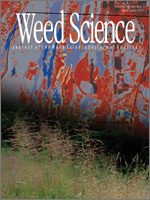Ludwigia is an important broadleaf weed of direct-seeded rice in Asia. Crop interference that relies on shading may have potential as a component of integrated weed management strategies but it requires understanding the extent to which rice can interfere with weed growth and how these weeds may respond. The growth of ludwigia was studied when grown alone and in competition with 4 and 12 rice (cv. IR72) plants. Rice interference reduced ludwigia height, number of branches, and shoot and root biomass. However, ludwigia showed the ability to reduce the effects of rice interference by increasing leaf weight ratio, increasing stem and leaf biomass in the upper half of the plant, and increasing specific stem length. At 11 wk after seeding, for example, ludwigia grown with 12 rice plants had 38% greater leaf weight ratio compared to plants grown alone. When grown with 12 rice plants, the weed had 82% of its leaf biomass in upper half of the plant compared to only 25% in weeds grown alone. The results showed that ludwigia responded to rice interference with a combination of adaptations typical of many weed species. Despite such plasticity, the control of ludwigia may be achieved by dense rice stands and increasing interference.
Nomenclature: Ludwigia, Ludwigia hyssopifolia (G. Don) Exell; rice, Oryza sativa L





